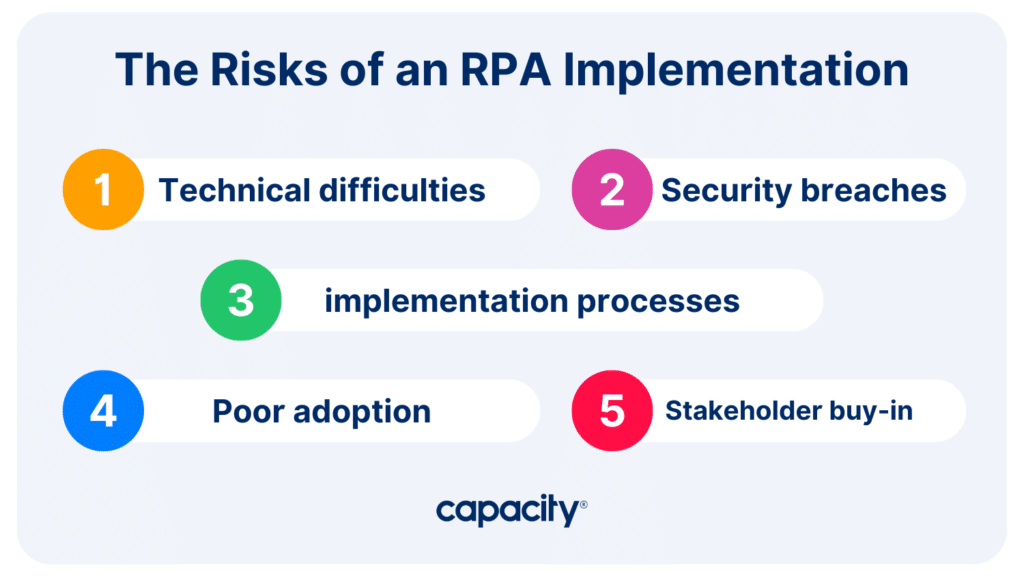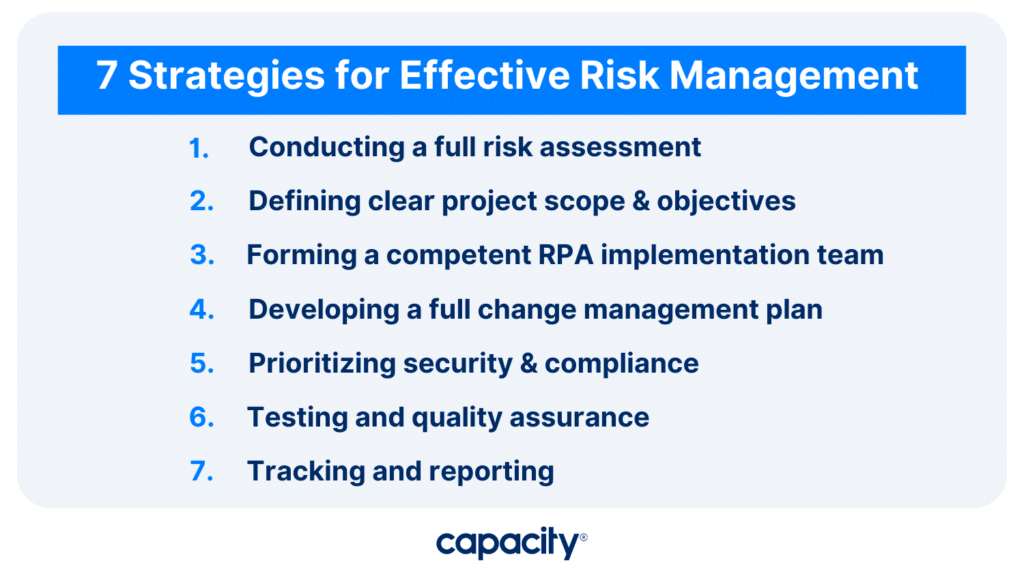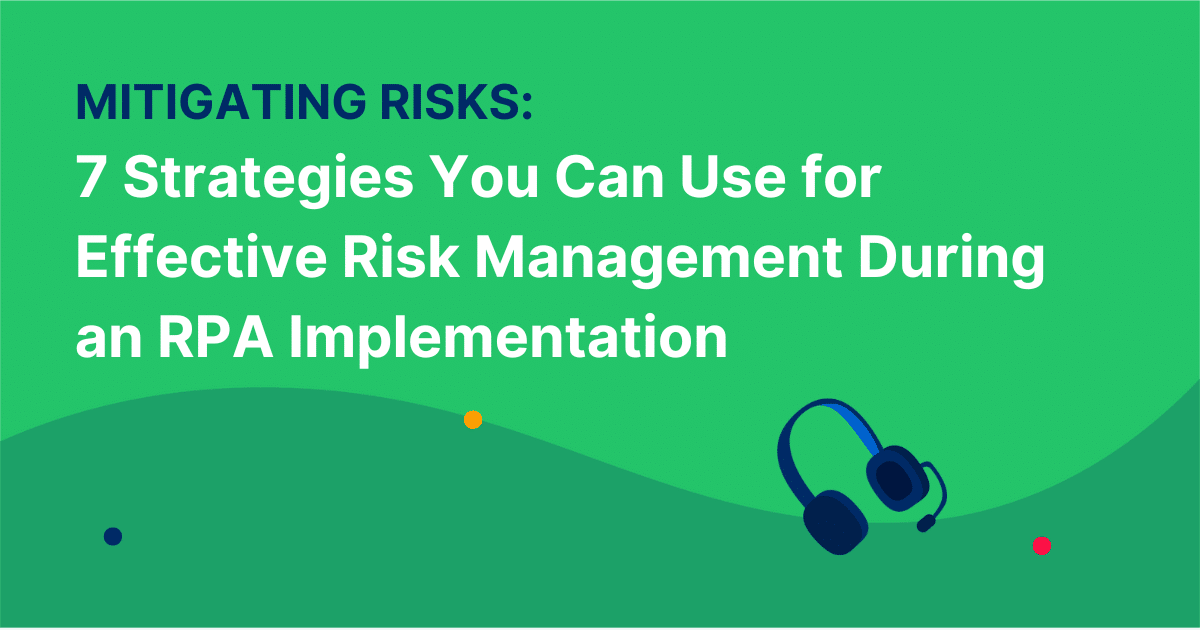As businesses of all kinds look to implement robotic process automation (RPA) for greater efficiency and cost savings, it’s unavoidable that risks are likely to arise in the process. Yet without an effective risk mitigation plan, companies may be looking at a hit to their bottom line if something goes wrong. That’s why it’s important to understand the potential risks associated with RPA—and why mitigating risk before you get started is crucial for successful implementation and long-term growth. In this blog post, we’ll unpack seven key strategies you can use for proper risk management so that your RPA investment pays off as intended over time.
Understanding the Risks of an RPA Implementation
Robotic process automation (RPA) offers a wide range of benefits to businesses, from increased productivity to improved customer service. However, it’s crucial for business leaders to understand the risks associated with RPA implementation to ensure they can optimize their investments. These risks include technical difficulties, security breaches, poor adoption and implementation processes, and stakeholder buy-in. Companies that do not have a well-defined RPA strategy risk reduced profitability and employee efficiency, while organizations that lack stakeholder buy-in face the possibility of stalled implementation. Mitigating the risks associated with RPA strategy, operational execution, stakeholder buy-in, change management, and maturity requires deploying a well-designed target operating model and a digitally augmented workforce. By understanding the risks and preparing to mitigate potential issues, businesses can fully maximize the potential benefits of RPA implementation.

7 Strategies for Effective Risk Management During Your RPA Implementation
Effective risk management during your RPA implementation is crucial to ensure the success of your project. By utilizing 7 strategies, you can minimize risks and maximize returns. The first strategy is to conduct a full risk assessment to identify potential issues and develop solutions before implementation. Next, defining clear project scope and objectives will help keep everyone on track and focused. Forming a competent RPA implementation team is also important to ensure that the project runs smoothly and efficiently. Developing a full change management plan will help mitigate resistance to the project’s new processes. Prioritizing security and compliance will ensure that the project remains secure and compliant throughout its lifecycle. Testing and quality assurance is an essential step to ensure that RPA implementation runs smoothly with minimal disruption. Lastly, tracking and reporting will provide not only visibility but also a continuous improvement cycle for the project. With these 7 strategies in mind, you can implement your RPA effectively and confidently.

Conducting a full risk assessment
When considering implementing RPA, it’s vital to consider all the potential risks involved. Conducting a full risk assessment can help identify the potential risks so that the business can take steps to mitigate them. To do this, companies should assess the impact that bot development will have on their existing controls and determine the potential risks that could arise from automation. It’s important to monitor transactional logs and watch for any unexpected activities to ensure that the automated process runs smoothly. With these precautions in place, businesses can be confident that their RPA implementation will be successful and risk-free.
Defining clear project scope & objectives
Regarding RPA implementation, one of the most critical steps is defining clear project scope and objectives. Without a clear plan in place, it’s easy for things to go off track or even fail altogether. Choosing the right processes is essential to achieving success, and defining your goals upfront can help you make those crucial decisions. Communication is also key – ensuring that all stakeholders are informed and on board with the objectives will help to keep everyone on the right track. Finally, setting specific milestones with measurable objectives will allow you to closely monitor progress and adjust as needed. By maximizing the benefits of automation through careful planning and goal setting, your RPA implementation will surely be a success.
Forming a competent RPA implementation team
The success of an RPA implementation project lies in the hands of a competent team that brings together diverse skills and expertise. To ensure that everyone is on the same page, clear and timely communication channels are necessary right from the outset. Effective communication is especially important when it comes to addressing concerns and dispelling fears. It is vital to manage the expectations of all stakeholders, ranging from the leadership team to associates at the grassroots level. Having a thorough and open discussion about why and how a process will be automated can help allay any fears that associates may have regarding automation taking over their jobs. Establishing trust and understanding across all business units is key to ensuring an effective and successful RPA implementation project. Only through clear and engaging communication can this be achieved.
Developing a full change management plan
Implementing RPA technology is no small feat, especially if you approach it solely from a technological perspective. If you don’t prioritize the people and business process aspects, your robotic process automation endeavor is bound to fail. Pushback from managers and staff who don’t know how to use the technology or are afraid of it can significantly hinder your progress. That’s why implementing RPA technology necessitates process improvements as well. Failure to manage change effectively when it comes to people and procedures can cause your users to oppose your RPA program or even cause it to fail entirely. The key to successful change management, therefore, lies in striking the right balance between people, process execution, and technology.
Prioritizing security & compliance
When implementing RPA, it is essential to prioritize security and compliance. Following Gartner’s 4-step action plan for Security and Risk Management leaders can help mitigate risks associated with RPA. Additionally, it’s crucial to enhance software development practices to include secure bot development and deployment. Treating a bot like a user is a good practice to follow, which includes creating a separate set of credentials. Utilizing two-factor authentication and maintaining a password vault to store bot credentials is also essential. Furthermore, establishing mechanisms to identify, avoid, and control bot abuse is necessary. Always remember to grant only the necessary permissions to the bots and ensure all transactions are correctly logged. By reviewing RPA scripts and logs regularly, you can ensure maximum security and compliance in your RPA implementation.
Testing & quality assurance
Tracking and reporting
When it comes to RPA implementation, tracking and reporting are critical components in determining success. Measuring the performance of your robotic process automation efforts can help you identify areas of improvement, optimize your bot portfolio, and ultimately achieve expected business value. From total automated processes to expected business value, there are numerous RPA metrics that you may already be tracking. These operational metrics not only shed light on the growth and evolution of your RPA programs but also quantify the cost and time savings that result from having bots execute processes. By monitoring and analyzing RPA metrics, you can stay on top of your automation efforts and ensure that you are realizing maximum benefits.
Taking the time to strategically manage risks before your RPA implementation is imperative for successful adoption and long-term operations. We’ve reviewed seven strategies to help you ensure best practices and reduce unexpected outcomes during and after an automation rollout. Now it’s time to put these recommendations into practice! Let us be your guide in the process: trust our team of experts to help you get started with RPA risk mitigation today. From creating a project plan that addresses security needs to ensuring stakeholder engagement throughout every step of the automation journey, our experience can point you in the right direction. Ready to try automation in your environment? Get started for free today!

Automate Your Work
Capacity’s enterprise AI chatbot can help:
- Answer FAQs anytime, anywhere
- Find relevant documents within seconds
- Give surveys and collect feedback












































